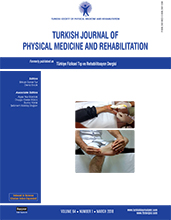Comparison of the short-term effects of the conventional motorized traction with non-surgical spinal decompression performed with a DRX9000TM device on pain, functionality, depression, and quality of life in patients with low back pain associated with lumbar disc herniation: A single-blind randomized-controlled trial
2 Department of Physical Medicine and Rehabilitation, Ankara Physical Therapy and Rehabilitation Training and Research Hospital, Ankara, Turkey
3 Department of Physical Medicine and Rehabilitation, Kayseri Training and Research Hospital, Kayseri, Turkey DOI : 10.5606/tftrd.2017.154 Objectives: This study aims to compare the efficiency of conventional motorized traction (CMT) with non-surgical spinal decompression (NSD) using the DRX9000TM device in patients with low back pain associated with lumbar disc herniation (LDH).
Patients and methods: Between March 2009 and September 2009, a total of 48 patients (29 females, 19 males; mean age 43.1±9.8 years; range, 18 to 65 years) were randomized into two groups. The first group (n=24) underwent CMT and the second group (n=24) underwent NSD for a total of 20 sessions over six weeks. The patients were evaluated before and after the treatment. Pain was assessed using the Visual Analog Scale (VAS), functional status using the Oswestry Disability Index (ODI), quality of life using the Short Form-36 (SF-36), state of depression mood using the Beck Depression Inventory (BDI), and the global assessment of the illness using the Patient`s Global Assessment of Response to Therapy (PGART) and Investigator`s Global Assessment of Response to Therapy (IGART) scales.
Results: There was no significant difference in the evaluation outcomes before the treatment between the groups. However, a statistically significant decline was found in the VAS, ODI, and BDI scores after the treatment in both groups (all p<0.001). Except for two subgroups, no significant changes were observed in the SF-36 form. Assessment of `marked improvement` was globally most frequently reported one in both groups. No significant difference was observed in the evaluation outcomes after treatment between the groups.
Conclusion: Our study results show that both CMT and NSD are effective methods in pain management and functional status and depressive mood improvement in patients with LDH, and NSD is not superior to CMT in terms of pain, functionality, depression and quality of life.
Keywords : DRX9000TM; Low back pain; spinal decompression; traction

















